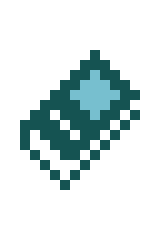On the Origins and Nature of the Dark Calculus
|
1 lb. Weight | |
Potential
Mods? |
|
|---|---|
Character
|
= |
ID?
|
DarkCalculus |
Spawns in
|
|
Infobox data from game version 2.0.207.99
| |
On the Origins and Nature of the Dark Calculus} is a book. Its covers are black with a light blue stripe. Its contents describe "dark calculus" or "penumbra calculus", a mysterious formal system where theorems proven using it immediately become false upon proof. This is a contrapositive version of umbral calculus from the mid 1900s, where proofs that supposedly cannot be true for determining the identity for polynomial equations resulted in the correct identities anyway. "Penumbra" in this case means "Partial darkness".
Notes on Formal Systems
|
|
Formal systems represent ways of reasoning about abstract concepts. For example, propositional calculus is a formal system that focuses on logic. Say that "If P is true, then Q is true" and "P is true". Therefore, we can conclude "Q is true". "If", "Then", and "Therefore" are represented by symbols of the propositional calculus. The horizontal line represents an "inference rule," which is a single step of reasoning from premises to conclusion; in this case, the rule for "If/Then", also called "modus ponens".
Two noted real-world theorists of formal systems are mentioned in the text: Russell and Gödel. Bertrand Russell was a philosopher and mathematician whose achievements included proving that a "set of all sets" was logically inconsistent (Russell's Paradox), and developing a formal system for mathematics which avoided this paradox (the Principia Mathematica). However, Kurt Gödel's famous First Incompleteness Theorem showed that any formal system that can represent standard arithmetic will be able to state true sentences which (if it's logically consistent) it cannot prove. The key example is "this sentence is not provable", which he showed can be expressed in any sufficient system. His Second Incompleteness Theorem demonstrated that a consistent system also cannot prove its own consistency. Gödel's work essentially killed David Hilbert's dream of a single complete system of purely formal mathematics.
Summary
A theorist from the seminary the Cupola formulated the basic concept of the dark calculus. It became a full fledged formal system, which defines the grammar, symbols, and set of rules to derive further concepts and theorems.
In mathematics, a theorem is a sort of statement about how the universe functions and must be proven with proofs. Proofs are essentially the step by step guide to how the theorem works. In this case, some theorems proven using dark calculus will become false once the proofs are complete. With this discovery, systems based off of dark calculus were created and even more fragile - not only do the conclusions of the system become false upon completing certain proofs, but the basic system itself starts falling apart.
Because the proofs must be in some observable state in order to be made false, some theorists predicted that there is some level of self-awareness to the dark calculus. They created a complex computer system for use of dark calculus and launched it into space to prevent any outside observation. The results of their research are unknown, but caused the use of the dark calculus and all related formal systems to be strictly prohibited. The opinion was unanimous, including Ptoh, who agreed by imploding a research station. Most records surrounding the dark calculus have been or attempted to have been removed from written history.
